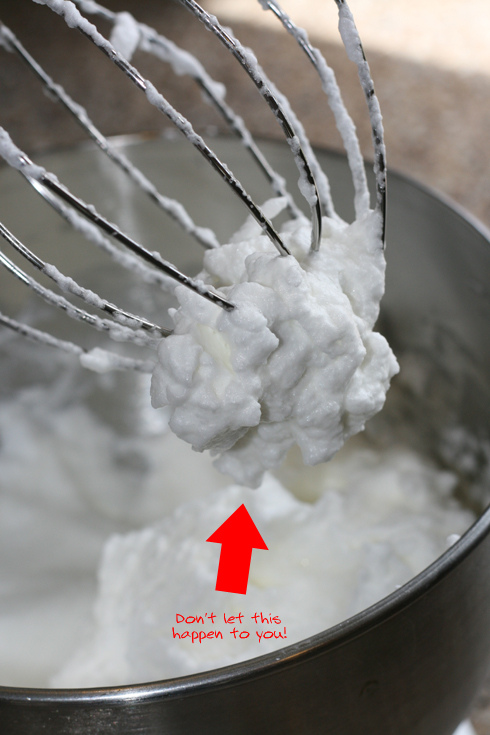







|
We often see recipes that require beating of egg whites to a particular firmness; and sometimes they may use the terms "stiff peak" or "soft peak". We often see these terms in recipes of macarons, meringues, marshmallows, souffle, etc. Just what is the difference between soft and stiff peaks?
The first stage of beating egg whites is the foamy stage, where you will see bubbles and foams. It is still liquidy and does not hold any shape at this stage.
The next stage is the soft peak stage, where you will observe that the egg whites will mound without any sharp tips (it will slump over). If you were to continue beating, it will eventually reach stiff peaks which should look like this: 
See the difference between soft and stiff peaks? Stiff peaks appear to be more firm and has a sharp, standing tip when you lift the beater.
Source: Food with Feeling
To double check that you have beaten the egg white until stiff peaks have formed, you can even try to turn the bowl with the egg whites upside down. The egg whites should not flow out at all! ;) If it flows out, that means it is still at its soft peaks. Another way of checking is of course to stop beating for a while and check your beater like the picture shown above. If it has a sharp, standing tip then it has reached the stiff peak.
One thing to take note is that one should not overbeat it. If you continue to have it beaten past its stiff peaks, it will end up looking like this:

It looks kind of like those shaving cream, doesn't it? 😂 If the egg whites become overbeaten, it will become dry and clump together. And if added to other ingredients, it will break down the batter and unable to create the product that you intend to do so. Hence, always be careful. It's not easy but as long as you are careful and observant enough, this should not be happening :)
Source: Whisk Kid  A picture summary of foamy egg white, soft peaks, stiff peaks and overwhipped egg white. Source: Fountain Avenue Kitchen And now, I am going to give some tips as to how to go about getting these peaks. TIP 1: Make sure there is no trace of egg yolks in the egg whites and that the bowl you are using is clean and dry. Any water droplets or egg yolk are regarded as contamination and may affect the outcome of your beaten egg whites. TIP 2: Use room temperature eggs. This is so that it will achieve the fullest volume. If you have refrigerated the eggs, leave it out in room temperature for at least 30 minutes before beating it. TIP 3: Beat the eggs at slow speed until they are foamy and then gradually increase the speed to medium-high. It will then reach the soft peak stage before eventually reaching the stiff peaks. Stop beating once you have reached the peak that you want. Otherwise, it will become overbeaten. TIP 4: Sometimes, sugar is added into the egg whites (e.g. meringues or macarons) to be beaten together to obtain stiff peaks. You should not add in all the sugar at one go. Rather, you should have them added little by little at different times (i.e. add 1/3 of the sugar into the egg white and then beat it for a short while. After that add another 1/3 and have it beaten agn. Lastly, add the remaining sugar and continue beating until you get your desired peak). The presence of sugar will also bring about a glossy appearance for the stiff peaks. TIP 5: I can't really be sure on how long to beat the egg whites for cos it kind of differs in terms of what kind of mixer you are using (hand-held mixer, stand mixer - in fact, it is easy to overbeat the egg whites using stand mixer) and the speed that you are using (the speed might be different for different types of mixers). But if I really need to state the amount of time, I would say that it will take around 5-6 minutes to reach stiff peaks when you use a hand mixer. If it is longer than that, it will most likely become overbeaten. I hope these tips help! :) |
0 Comments:
Post a Comment